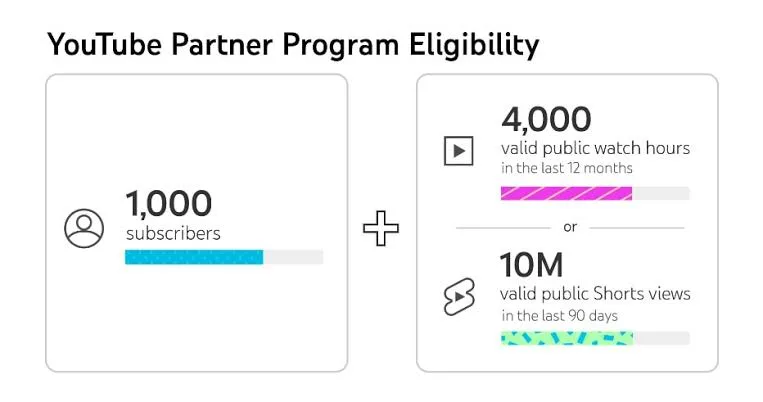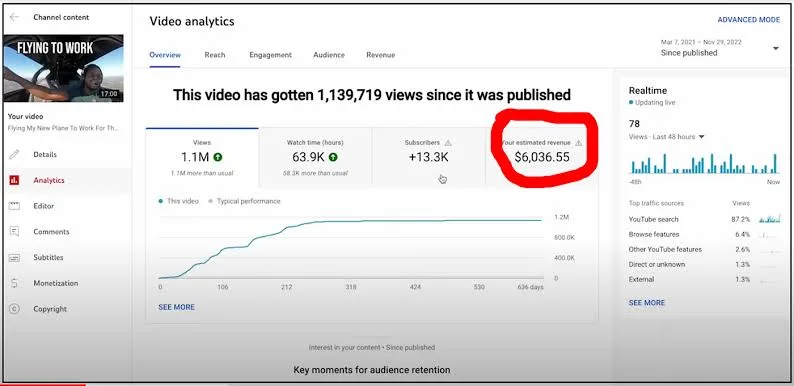YouTube has evolved from a mere video-sharing platform into a lucrative career path for many creators across the globe. As more individuals explore content creation, one of the most commonly asked questions is: “How much does YouTube pay for 1 million views?” While there isn’t a fixed answer due to the variety of influencing factors, this article will give a comprehensive overview based on real data, creator experiences, and monetization mechanics.
Let’s dive into the nuances of YouTube earnings and understand what 1 million views could truly mean for a creator’s income.
YouTube Monetization Basics:
To begin earning money on YouTube, a creator must be part of the YouTube Partner Program (YPP). To qualify, a channel needs at least 1,000 subscribers and 4,000 watch hours within the past 12 months. Once eligible, creators can monetize their content through various means:

- Ad Revenue: Income from ads shown before, during, or beside videos.
- Channel Memberships: Monthly payments from subscribers.
- Super Chats and Stickers: Tips during live streams.
- YouTube Premium Revenue: Share of subscription fees.
However, the bulk of income for most creators comes from ad revenue. This is calculated using CPM (Cost per Mille or Cost per 1,000 views), which varies depending on the video topic, location of the viewers, and audience engagement. For example, finance-related videos tend to attract higher-paying ads than entertainment vlogs.
Factors That Affect YouTube Earnings:
Several key variables influence how much a creator earns for 1 million views:
- CPM (Cost per Mille): The rate advertisers pay per 1,000 views. This can range from $0.50 to over $20.
- RPM (Revenue per Mille): What the creator actually earns per 1,000 views, often 45% less than CPM because YouTube takes a cut.
- Viewer Geography: Views from countries like the USA, UK, Canada, and Australia typically yield higher CPMs.
- Audience Demographics: Advertisers target specific age groups and income brackets.
- Content Category: Tech, finance, and health videos earn more than comedy or music.
- Viewer Engagement: Videos with longer watch times and high engagement attract better-paying ads.
Each of these factors plays a role in determining the final payout for a video with 1 million views. It’s rarely a fixed amount.
Real-Life Earnings from 1 Million Views:
YouTuber experiences provide valuable insight into actual payouts. For example:
- A tech creator reported earning $8,500 from a video with 1 million views.
- A lifestyle vlogger earned only $1,200 for the same view count.
- Finance YouTubers often report payouts as high as $15,000 for 1 million views.
This disparity stems from the CPM rates assigned to each niche. On average, most creators earn between $2,000 to $5,000 for 1 million views. However, some earn significantly more if their niche is advertiser-friendly and attracts a premium audience.

It’s also worth noting that earnings can fluctuate based on seasonality. For instance, advertisers spend more during the holidays, pushing CPM rates up during November and December.
CPM vs RPM: Understanding the Difference:
Let’s break down the concepts of CPM and RPM to better understand earnings:
- CPM (Cost Per Mille): This is what advertisers pay YouTube for every 1,000 ad views. CPM can be as low as $1 and as high as $25 depending on the niche and viewer location.
- RPM (Revenue Per Mille): This is what the creator actually receives per 1,000 video views. RPM considers all revenue sources (ads, Premium, Super Chat) and factors in YouTube’s 45% cut.
Example:
- CPM = $10
- YouTube takes 45% = $4.50
- Creator earns = $5.50 RPM
For 1 million views:
- Total Earnings = $5.50 x 1,000 = $5,500
Understanding this breakdown helps creators manage expectations and strategize content for higher-earning topics.
Regional Differences in YouTube Payments:
Location is a significant determinant of earnings. Let’s compare CPMs from different countries:
- United States: $6 – $20
- United Kingdom: $5 – $15
- India: $0.50 – $2
- Philippines: $0.30 – $1
- Canada: $5 – $18
This disparity means a video with 1 million views in the U.S. can earn up to 10 times more than one in India. Creators targeting international or U.S.-based audiences generally see better earnings. Language also plays a role—English videos often attract global advertisers.
Creators aiming to increase earnings should consider SEO strategies that attract viewers from higher-paying regions, including using English subtitles or dubbing content in English.
How YouTube Niche Affects Earnings?
Different niches attract different advertisers, and some pay more than others. High-paying niches include:
- Finance & Investing
- Real Estate
- Technology
- Online Marketing
- Education
On the other hand, lower-paying niches include:
- Music (due to copyright claims)
- Gaming (high competition)
- Comedy
- Vlogging
Estimated CPM by niche:
- Finance: $15 – $25
- Tech: $6 – $12
- Education: $4 – $10
- Lifestyle: $3 – $8
- Entertainment: $1 – $4
Choosing a niche that aligns with advertiser demand can significantly increase earnings per 1 million views.
Alternative Monetization Avenues:
Besides ad revenue, YouTubers can diversify their income streams to boost overall earnings:
- Sponsorships: Brand deals can bring in thousands per video, often exceeding ad revenue.
- Merchandise Sales: Selling custom products boosts profits.
- Affiliate Marketing: Promoting products and earning a commission per sale.
- Courses & eBooks: Ideal for creators in educational or how-to niches.
- Crowdfunding: Platforms like Patreon offer monthly support from fans.
These strategies can push total earnings for 1 million views well beyond ad revenue alone, sometimes multiplying it by 2x or 3x.
Seasonal Trends in YouTube Revenue:
Ad spending fluctuates throughout the year. Here’s how:
- High CPM Months: November and December (holiday season)
- Low CPM Months: January and February (post-holiday slump)
Advertisers boost spending during major events and festivals, creating spikes in earnings. Creators should plan content calendars around these trends to maximize income. For instance, posting finance or shopping guides in Q4 can yield higher CPMs.
Understanding seasonal trends allows creators to time their high-effort videos for months with the most revenue potential.
Conclusion:
Achieving 1 million views is a milestone, but the monetary value varies widely. While it may result in anywhere from $500 to $15,000 in earnings, strategic planning can amplify returns. Creators who understand CPM, optimize their niche, and explore multiple revenue streams can maximize profits from their audience. Remember, views are just one metric.
Engagement, retention, and brand building play critical roles in long-term success. Ultimately, while 1 million views is a powerful number, what truly matters is how you leverage those views.
Frequently Asked Questions:
Yes, if the channel is eligible for monetization through the YouTube Partner Program.
YouTube takes 45% of ad revenue, leaving 55% for the creator.
No, Shorts usually have lower CPMs and rely more on the Shorts Fund and brand deals.
Yes, English language content often attracts higher-paying advertisers.
Currently, finance, tech reviews, and educational content are among the fastest growing and highest paying niches.
